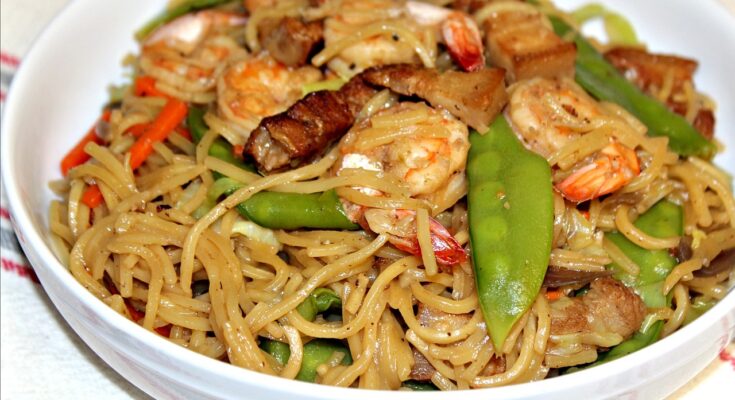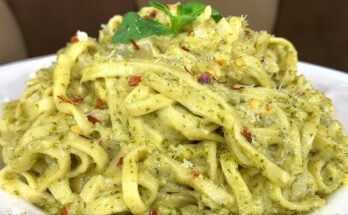Filipino Pancit Recipe: Pancit is more than just a noodle dish in the Philippines—it’s a cultural icon. Pronounced as “pan-sit,” this beloved recipe traces its origins to Chinese immigrants, but over the years, it has evolved into something uniquely Filipino. The word “pancit” actually comes from the Hokkien term “pian e sit,” meaning “something conveniently cooked.” True to its name, it’s a quick, flexible, and hearty dish that’s easy to whip up for lunch, dinner, or any festive occasion.
In every Filipino gathering, whether it’s a birthday, fiesta, or a simple get-together, you’ll find a tray of pancit at the center of the table. It’s not just because it’s delicious, but also due to the Filipino belief that noodles symbolize long life and good health. So, serving pancit is like wishing everyone joy, health, and longevity.
There are several variations of pancit, each using different noodles and ingredients, but the essence remains the same: stir-fried noodles mixed with meat, vegetables, and a tasty sauce that brings everything together.
Why Pancit is Loved in Filipino Households
Pancit holds a special place in every Filipino heart. It’s budget-friendly, easy to cook, and incredibly customizable. You can make it with whatever you have in the fridge—be it leftover chicken, slices of pork, or just plain veggies. Its versatility is what makes it a weeknight favorite for busy moms and dads trying to feed a hungry family.
Aside from its practicality, pancit is a flavor bomb. Every bite is a medley of textures and tastes—soft noodles, crunchy veggies, savory meats, and that umami punch from soy sauce and broth. Plus, it’s a one-pan dish, which means less clean-up!
It also bridges generations. Kids love it, elders cherish it, and everyone in between appreciates its comfort. When someone says “pancit,” it doesn’t just refer to food—it evokes memories, stories, and traditions that are passed down through every noodle-filled forkful.
Ingredients You’ll Need
Noodles – The Star of the Show
The foundation of every pancit dish lies in the noodles, and choosing the right one is essential. For this step-by-step recipe, we’re using pancit bihon—thin rice noodles that are light, easy to prepare, and soak up flavors like a sponge. You can find them in Asian grocery stores labeled as “bihon” or “rice vermicelli.”
But don’t worry if you only have egg noodles or pancit canton on hand. These thicker, yellow wheat noodles are also widely used and give a richer, chewier bite. Just adjust the cooking time since canton noodles take a bit longer to soften than bihon.
Whichever noodle you pick, just remember this golden rule: don’t overcook them. No one wants mushy pancit. Soak rice noodles in warm water just until they’re pliable, and let them finish cooking in the pan with all the other ingredients.
Proteins – Make It Hearty
Pancit is delicious on its own, but adding protein turns it into a complete meal. Traditional pancit recipes often include a mix of chicken, pork, and sometimes shrimp. Here’s what you’ll need:
- Chicken breast or thigh – sliced thinly for quick cooking.
- Pork belly or shoulder – for a richer taste.
- Shrimp (optional) – adds sweetness and a seafood twist.
Pro tip: Leftover lechon, rotisserie chicken, or even sausage can be thrown in if you’re short on time. The beauty of pancit lies in its flexibility.
Veggies – For Color and Crunch
No pancit is complete without a vibrant mix of vegetables. Not only do they add a splash of color, but they also bring that much-needed crunch and freshness. Here are the essentials:
- Carrots – julienned for easy mixing.
- Cabbage – napa or green, shredded thin.
- Green beans – sliced diagonally for presentation.
- Celery and onions – to build flavor from the base up.
- Garlic – minced, because Filipino food without garlic is just sad.
You can also throw in snow peas, bell peppers, or bean sprouts if you’re feeling fancy or want extra fiber.
Sauces and Seasonings
This is where the magic happens. Pancit is flavored mainly with soy sauce, but the layering of seasonings gives it that crave-worthy taste. You’ll need:
- Soy sauce – for saltiness and depth.
- Oyster sauce – adds a savory, umami-rich boost.
- Chicken broth or water – to help soften the noodles and infuse flavor.
- Black pepper – for a little kick.
- Calamansi or lemon – a squeeze of citrus at the end brightens everything up.
Want to go bold? Add a dash of fish sauce (patis) for an extra punch of authenticity.
Kitchen Tools You’ll Need
To cook pancit efficiently, you don’t need fancy tools. A large wok or deep skillet is your best friend—this dish is all about tossing and mixing. Other helpful tools include:
- Sharp knife – for prepping your proteins and veggies.
- Cutting board – one for meats and one for produce.
- Tongs or spatula – to stir without breaking the noodles.
- Mixing bowls – for soaking noodles and organizing ingredients.
And that’s it! Simple tools for a simple dish that’s full of flavor.
Step-by-Step Cooking Instructions
Step 1: Prep All Your Ingredients
Before you turn on the stove, make sure all your ingredients are ready to go. Pancit cooks fast, and the last thing you want is to be scrambling to chop vegetables while your meat is burning. This is your mise en place moment—everything in its place.
Start by soaking your bihon noodles in warm water. Let them sit for about 10 to 15 minutes until they become soft but not mushy. Then, drain and set aside. While your noodles soak, slice your chicken, pork, and shrimp if using. Make sure to cut them thinly for even and quick cooking.
Next, wash and slice all your vegetables. Julienne the carrots, shred the cabbage, and slice your green beans. Mince the garlic and onions. Having everything chopped and within reach makes the cooking process smooth and stress-free.
Place your sauces—soy sauce, oyster sauce, and broth—within arm’s reach. You’ll need to move quickly once the heat is on, and fumbling with bottles in the middle of cooking will throw off your flow.
Step 2: Cook the Proteins First
Now it’s time to bring the heat. In your large wok or skillet, add a tablespoon of oil over medium-high heat. Start by cooking the pork until it’s browned and slightly crispy. This renders out fat that adds tons of flavor. Once done, push it to the side of the pan.
Next, add your chicken slices and cook until they’re no longer pink. If you’re using shrimp, toss them in last, just until they turn pink and curl up—don’t overcook them or they’ll become rubbery. Once all the meat is cooked, remove it from the pan and set it aside on a plate.
This method ensures your proteins are cooked perfectly without getting lost in the mix of veggies and noodles later. Plus, the caramelized bits left in the pan? That’s where the flavor lives.
Step 3: Sauté the Vegetables
In the same pan, add a bit more oil if needed and toss in your minced garlic and onions. Sauté them until fragrant—your kitchen should start smelling like you’re about to serve something amazing.
Now add the carrots and green beans. Stir-fry for 2–3 minutes, just enough to soften them a bit. Then, toss in the cabbage and cook until slightly wilted but still vibrant. You want the veggies to retain their crunch and color—overcooked vegetables will make your pancit soggy and dull.
Once your veggies are cooked to perfection, push them to the side and make space in the center of the pan.
Step 4: Combine Everything with the Noodles
Time for the grand finale! Add your soaked and drained noodles to the center of the pan. Pour in your soy sauce, oyster sauce, and chicken broth. Use tongs or a large spatula to gently mix the noodles with the sauce. Stir carefully to avoid breaking the noodles apart.
Toss in the cooked proteins and mix everything together. Keep tossing until the noodles absorb the sauce and everything is well combined. This step might take 5 to 7 minutes, but it’s worth it—every strand of noodle should be coated in flavor.
Finish with freshly ground black pepper and a generous squeeze of calamansi or lemon juice. This final citrus touch cuts through the richness and ties all the flavors together.
Cooking Tips for Perfect Pancit
Getting pancit right is all about balance—flavors, textures, and timing. Here are a few pro tips:
- Don’t over-soak the noodles: They should be soft but still firm since they’ll continue to cook in the pan.
- Use high heat: This ensures that your vegetables stay crisp and your noodles get that perfect stir-fried texture.
- Taste as you go: Your broth and soy sauce might vary in saltiness, so adjust the seasoning as needed.
- Layer your ingredients: Add proteins and veggies back gradually to keep textures distinct.
- Use calamansi if available: This native citrus fruit adds authenticity and a signature zing that lemon can’t quite replicate.
Variations of Pancit
Pancit Bihon
This version uses thin rice noodles and is one of the most common pancit dishes across the Philippines. It’s light, easy to make, and typically cooked with chicken, pork, and a mix of vegetables. If you’re a pancit newbie, this is a great place to start.
Pancit Canton
Thicker and more filling, Pancit Canton is made with egg noodles and has a slightly chewy texture. It’s richer than bihon and often includes more sauce. This is the go-to pancit when you want something hearty and comforting.
Pancit Malabon
This seafood-heavy variant uses thick rice noodles and a savory shrimp sauce. Pancit Malabon is often garnished with hard-boiled eggs, crushed chicharrón, and scallions. It’s packed with umami and perfect for special occasions.
Serving Suggestions
Pancit isn’t just a dish—it’s a centerpiece. Whether you’re preparing it for a family dinner or a fiesta, how you serve it makes all the difference. Presentation is key, and it’s surprisingly simple to elevate your pancit to feast-worthy status with just a few extra touches.
Start by transferring the cooked pancit onto a large serving platter. Smooth it out with tongs or a spatula, ensuring the vegetables and proteins are evenly distributed throughout the noodles. Don’t just pile everything in the middle—spread it out, so everyone gets a bit of everything in every bite.
Now for the fun part: toppings. A classic pancit is typically garnished with:
- Sliced hard-boiled eggs – for added protein and visual appeal.
- Chopped green onions – adds freshness and a pop of green.
- Calamansi halves or lemon wedges – offer a citrus boost with every bite.
- Crushed chicharrón (pork rinds) – adds crunch and extra flavor.
- Fried garlic – for that irresistible aroma and golden crispness.
Serve with a side of bread or pan de sal for that authentic Filipino touch. And of course, don’t forget the dipping sauces. Soy sauce mixed with calamansi juice or a bit of spiced vinegar pairs perfectly with pancit and adds that traditional “sawsawan” kick.
Whether you’re serving it hot off the stove or letting it sit buffet-style, pancit holds up well and tastes just as great after sitting out for a bit—another reason why it’s a favorite party dish in Filipino homes.
Storage and Reheating Tips
Got leftovers? Lucky you! Pancit keeps really well, and many say it even tastes better the next day once the flavors have had more time to mingle.
Here’s how to store and reheat it without sacrificing flavor or texture:
- Refrigerate: Let your pancit cool completely, then store it in an airtight container. It’ll stay fresh in the fridge for up to 3 days.
- Freeze (if needed): If you’ve made a big batch, pancit can be frozen. Place it in a freezer-safe container and store it for up to a month. Be aware that freezing might slightly change the texture of the noodles, but it’s still delicious.
- Reheat: For best results, reheat pancit in a skillet over medium heat. Add a splash of water or broth to loosen the noodles and prevent drying. Stir frequently until heated through. You can also use the microwave—just make sure to cover it and add a little moisture before nuking it.
Avoid reheating it multiple times as that can make the noodles gummy. Instead, reheat only what you’ll eat to keep every portion fresh and tasty.
FAQs about Filipino Pancit Recipe
Can I make Pancit vegetarian?
Absolutely! Just skip the meat and seafood, and load up on vegetables. You can also use tofu or plant-based protein as a substitute. Be sure to use a vegetable broth instead of chicken for a flavorful base.
What’s the best noodle for Pancit?
It depends on the type of pancit you’re making. For a lighter dish, go with bihon (rice noodles). For a heartier meal, pancit canton (egg noodles) is ideal. Both soak up flavor well but offer different textures.
Can I make Pancit ahead of time?
Yes! Pancit actually tastes better after it sits for a while. You can cook it a day ahead and reheat it before serving. Just make sure to store it properly and add a bit of liquid when reheating to keep it from drying out.
Is Pancit gluten-free?
It can be! If you’re using rice noodles (bihon) and gluten-free soy sauce, then yes. Just be mindful of your sauces—traditional soy sauce often contains wheat, so opt for tamari or gluten-free versions.
What’s the difference between Pancit Canton and Bihon?
Pancit Canton uses yellow, wheat-based egg noodles, which are thicker and chewier. Pancit Bihon uses thin rice noodles, which are lighter and softer. Both are delicious but offer different eating experiences.
Final Thoughts
Pancit is more than just a noodle dish—it’s a slice of Filipino culture served on a plate. It’s about comfort, community, and celebration. Whether it’s your first time making it or you’ve grown up eating it at every family gathering, pancit has a way of bringing people together.
It’s an easy, budget-friendly meal that you can whip up on a weeknight, yet it’s elegant and flavorful enough to serve on holidays and special occasions. It adapts to whatever you have on hand, and with a bit of creativity, you can turn it into your own signature dish.
So next time you’re craving something hearty, delicious, and full of flavor, skip the takeout and give this pancit recipe a try. Your taste buds—and your family—will thank you.



